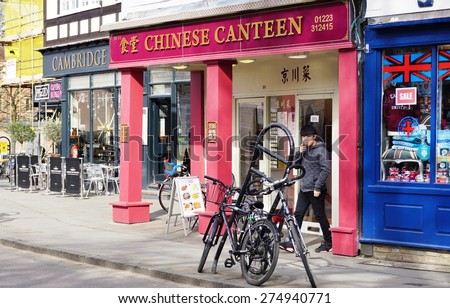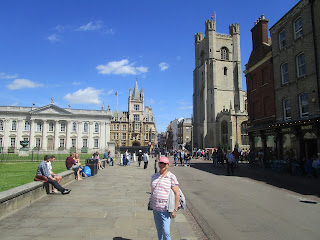This time we actually meant to go to Liverpool Station. We took the train to Cambridge University.
The Professor went online and booked seats for us for Saturday morning. We got to the station well before our train was due to leave and discovered that we could take an earlier train. The only problem was that the earlier train stopped at every little town between London and Cambridge. The one we had reserved seats on had only four stops. However, each stop was very brief. If you were there, you got on the train. If not, the train was gone.
A thoughtful stranger took a picture of us together.
Since we still had some time before the train would leave, we wandered around the station for awhile. Just outside the main entrance is this statue of children refugees from WW II. They came on the Kindertransport from all over Europe seeking safety in England.

{On a plaque on a nearby wall:}
Hope Square, dedicated to the Children of the Kindertransport, who found hope and safety in Britain through the gateway of Liverpool Street Station.
Association of Jewish Refugees, Central British Fund for World Jewish Relief, 2006.
{On a plaque behind the statues:}
Children of the Kindertransport
In gratitude to the people of Britain for saving the lives of 10,000 unaccompied mainly Jewish children who fled from Nazi persecution in 1938 and 1939.
"Whosoever rescues a single soul is credited as though they had saved the whole world." Talmud
Hope Square, dedicated to the Children of the Kindertransport, who found hope and safety in Britain through the gateway of Liverpool Street Station.
Association of Jewish Refugees, Central British Fund for World Jewish Relief, 2006.
{On a plaque behind the statues:}
Children of the Kindertransport
In gratitude to the people of Britain for saving the lives of 10,000 unaccompied mainly Jewish children who fled from Nazi persecution in 1938 and 1939.
"Whosoever rescues a single soul is credited as though they had saved the whole world." Talmud
Frank Meisler, Arie Ovadia, 2006

Another really attractive picture of me sleeping. We are just on a train this time instead of a "coach."
People do not travel on buses from London to Oxford or on a trip. It is a coach.
The Professor had consulted Rick Steves about visiting Cambridge but the guidebook did not mention anything about getting from the station to the middle of Cambridge. We saw a map posted on the street and set off on our own to find Cambridge University.
We walked along a street with large old houses on one side. A canal ran along the side of the road and each house had a bridge over the canal giving access to the property.
Walking along Trumpington Street we passed two "old schools," Gonville and Caius
Caius is one of the oldest and largest colleges of the University of Cambridge. Founded in 1348, the College combines the best of Cambridge tradition with 21st century teaching and research.
A peak inside the quad for Corpus Christi College.
All of the colleges were closed to the public because it was examination time. As a result, all of the tourists visiting Cambridge on Saturday had nowhere to go but to wander the streets. Most of the parks are part of one college or another and were inaccessible when we were there.
A strange clock on a Cambridge street.
The Corpus Clock is one of the newest and most distinctive public monuments in Cambridge. It is a unique and strange device for the measurement of time and is both hypnotically beautiful and deeply disturbing. It was invented, designed and given to Corpus Christi College, Cambridge, by Dr John C Taylor. The Clock is a remarkable mixture of very modern design and an ancient setting; of precision engineering and engaging whimsy...
The Corpus Clock has no hands, or digital numbers. Time is shown by concentric orbits of what appear to be flashing blue lights, darting or progressing at different rates around the circumference of the clock face.
Corpus Clock on the library wall of Corpus Christi
This intimidating soldier was standing outside of the Information center.
Open market with crafts and fresh fruit and vegetables for sale
Very different type of street sign from both Oxford and London
Oxford University Press
The most amusing part of the day was watching punting on the Cam. Very different levels of skill among the boatmen. Some looked as if they were part of a punt boat for hire system. Similar to taking a gondola in Venice. Others looked very much like novices.
A window full of Harry Potter souvenirs, including wands.
I can tell you for certain that this is called the Round Church.
The Church of the Holy Sepulchre, usually referred to as The Round Church, is an Anglican church in the city of Cambridge. It is located on the corner of Round Church Street and Bridge Street.
A quiet stretch of water.
Lunch at the Chinese Canteen
One of 544 Restaurants in Cambridge

We decided that this was a group tour which had booked tables for lunch at the Chinese Canteen.

Periodically we see a standard looking telephone box with the WiFi sign.
around the gardens and even sit on a bench for awhile.
Library of the college. On the grounds was also the Heong Gallery. A modern and contemporary art gallery at Downing College, named by Alwyn Heong, an alumnus of Downing College, who is a passionate supporter of the visual arts and a collector. The gallery is definitely of a different style from the rest of the college.
Downing is a new college compared with the ancient colleges of the university. Downing College in the University of Cambridge was founded in 1800 by the bequest of Sir George Downing. Set amidst 20 acres of magnificent grounds in the heart of the city, Downing College is a community of committed scholars and students, current and future leaders in their fields.
A sign that we could not resist. It is the street sign standing outside of the Bateman House.

























































































No comments:
Post a Comment